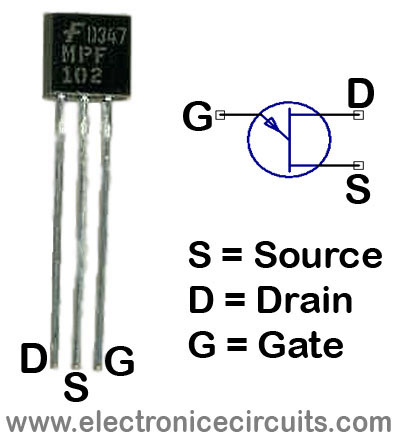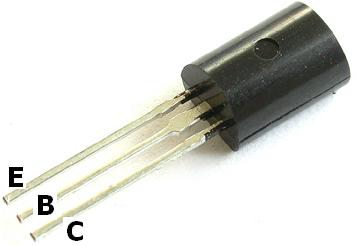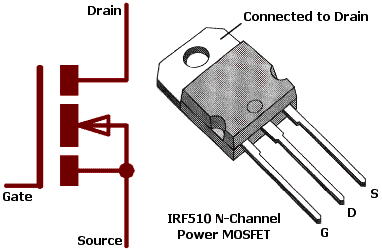Be aware that the information provided here is an overview of transistors in a general sense. Transistor circuit analysis (the nitty gritty) which is a part of microelectronics, involves an understanding of electric circuit fundamentals, and also considerable experience solving circuits using equivalent circuit models (lots of diagrams and math). If you want the nitty gritty, my best advice to you is to watch online video lectures that are being taught by university professors, like those by rolinychupetin YouTube channel. These online video and tutorials are long and in depth. I highly recommend starting with the BJT videos.
History and Introduction of Transistors
The transistor is a 60-year old component that amped computer technology up to what it is today. The first transistor was invented in 1947 by William Bradford Shockley, John Bardeen, Walter Brittain. (More on Transistor History).
The importance of the device was that it was the first electronically controllable resistor. So, you can imagine a transistor is like a carbon film resistor with a slide switch
Today, transistors are used in computers, robots, and many other creations that rely on logic. Transistor logic is accomplished by combining the switch like behavior of several transistors together.
Interesting Fact: The name, "Transistor" came from "Transforming Resistor." It is surprising, but the transistor is really a resistor that changes its resistance valuedepending on the input signal.
The Bipolar-Junction Transistor
The bipolar-junction transistor (BJT) has only 3 metal pins:
- Emitter (E)
- Base (B)
- Collector (C)
Transistors in general have 2 basic functions:
- Switch
- Amp
A SWITCH is a device that allows you to change values from on to off. This is also known as toggling. Such as the lights in your bedroom, they can be ON or OFF (two different values). The ON/OFF values are also referred to as "states" or more completely, "logic states,", in which ON means True (like "Yes") and OFF means False (like "No").
AN AMP is a device that increases an already defined value. A simple amp is a guitar amplifier. Notice amp is the start of the word amplifier.
With a little twist of thought a switch is an example of very an extreme amplifier. A switch is an "absolute" amplifier. What I mean by this is that a switch is usually 2 values that are extremes of one another (ON or OFF). An amplifier can be used to increase precision as well as distort precision of a value. The softer the guitar gets the harder it will be to hear.
Recap #1: ~all answers at the end of the post
a. An amp is used to _____ an already existing value.
b. A switch usually has only ____ values.
c. A standard transistor has ___ metal pins.
There are two sub-types of bipolar-junction transistors: The NPN (on left) and the PNP (on right).
 |
| NPN |
 |
| PNP |
PNP stands for "Positive Negative Positive"!
The difference between NPN and PNP transistors is the direction of the flow of electricity (current). In the images above you can see that from bottom to top the NPN pins are EBC ("Eat Big Cookies") and PNP pins are CBE (the reverse order).
PNP = Points iN Proudly
NPN = Not Pointing iN
IMPORTANT POINTS:
-An important note to make is that the B or BASE pin of the transistor is always in between the C (collector) and the E (emitter).
-Also, the NPN and PNP bipolar junction transistor both have their arrows pointing from base to emitter.
When buying the standard JFET transistors, both NPN or PNP, keep the NPN and PNP transistors in seperate labeled bags. It is very difficult, tedious, and down right frustrating to sort through a mixed group of JFETs (PNP and NPN). So, when you buy transistors, buy a SET OF NPN (maybe 20 or so) and keep them all together, in addition to a SET OF PNP (20 would be plenty for basics).
Recap #2:
a. The letter, "e" stands for ______.
b. The letter, "b" stands for ______.
c. The letter, "c" stands for ______.
d. The base pin is always between the ______ pin and the ______ pin.
e. NPN stands for ___________________.
PART 3: Transistors will Vary
Transistors mainly differ in the following ways:
-size (think about the tiny ones in your computer)!
-shape
-operation
-pin orientation
-level of voltage
The low voltage use transistors (JFETs) tend to be smaller than the high voltage use transistors (MOSFETs).
JFET stands for Junction Field-Effect Transistor.
 |
| JFET transistor |
MOSFET stands for Metal Oxide Semiconductor Field Effect Transistor
Did you know that microprocessors (CPU*) have millions/billions of microscopic transistors in them? Fresh reminder: Transistors are just special resistors.
Not only is it true, but it is an extremely important part of the computer. The microprocessor (millions of transistors and other micro electronics) is in charge of LOGIC and CALCULATIONS (Processing).
*Technically, CPU stands for Central Processing Unit which is a part of a microprocessor so the terms are not equivalent (technically). However, in the real world people use the terms CPU and microprocessor interchangeably.
Due to the fact transistors can act as switches, combinations of these switches/transistors can be used to represent data. When combined correctly transistors can function together as AND, OR, and NOT gates (AOI logic). AOI stands for And Or Invert. More on AOI and Logic later.
TTL = Transistor-Transistor Logic
RTL = Resistor-Transistor Logic
DTL = Diode-Transistor Logic
The average discrete transistor (both bipolar-junction and field-effect) is about 1.5 cm long. Now, can you imagine squeezing millions/billions of transistors into a CPU (Central Processing Unit) that is only about one squared inch big?!
 |
| Central Processing Unit (CPU) |
If it weren't for transistors, you would not be on my site reading this right now.
Recap #3:
a. __________s rely on transistors to perform logic operations
b. What does GDS stand for?
c. MOSFET stands for Metal-Oxide-___1c____-Field-___2c____-____3c_____.
d. JFET stands for _____________.
e. TTL stands for ____________.
Final Recap:
a. "Transistor", the term itself came from what original name. _____1a____ _____2a____
b. Bipolar-junction transistors are often abbreviated as _____'s.
c. Transistors two basic jobs are: __________ and _________.
The following videos are some of the BEST TRANSISTOR LESSON VIDEOS on the web
MORE TRANSISTOR WEBSITE ARTICLES:
KPSec Transistor Component
Talking Electronics: PNP or NPN
KPSec Transistor Circuits
Recap #1 Answers:
a. increase; amplify
b. 2
c. 3
Recap #2 Answers:
a. emitter
b. base
c. collector
d. collector, emitter
e. negative positive negative
Recap #3 Answers:
a. computers
b. Gate, Drain, Source
c. Metal-Oxide-Semiconductor(1)-Field-Effect(2)-Transistor(3)
d. Junction Field Effect Transistor
e. Transistor-Transistor Logic
Final Recap Answers:
a. Transforming(1) Resistor(2)
b. BJT
c. amplifying & switching






No comments:
Post a Comment